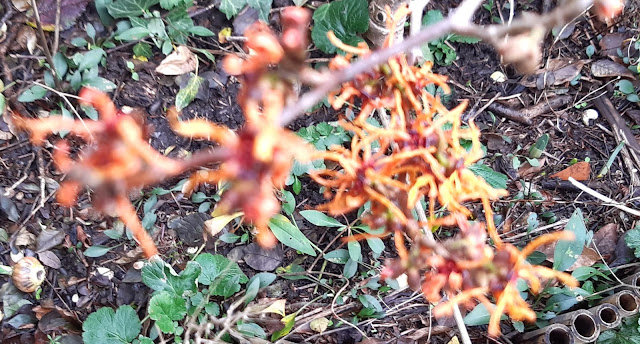 |
| Impressionist picture of Witch hazel in January |
At first glance out of the window, the winter garden is dank, wet, lifeless and boring. At second glance however, I see several shrubs that have been flowering all through January providing interest in colour and shape and also shelter and sustenance for birds and insects.
There is a Fatsia japonica with large hand-like leaves and pale green flowers in globose (there's a good word) clusters, a Viburnum bodnantense 'Dawn' with its pink flowers clustering on bare branches, a Garrya elliptica 'James Roof' with grey-green catkins and another viburnum, v. farreri (similar to bodnanense) in the front garden.
Garrya elliptica 'James Roof' Viburnum bodnantense 'Dawn'
But the two I have been enjoying particularly this month are the witch hazel (Hamamelis intermedia 'Jelena') and the winter honeysuckle (Lonicera fragrantissima).
The witch hazel is now eight years old, a gift from a good friend and is an interesting rusty colour, rather than the more usual bright yellow. Its spidery flowers appeared about two weeks ago in great profusion - the first year it's produced so many. It's about 3ft tall now, but could grow to 12ft if I let it, so eventually quite a big tree.
Hamamelis intermedia 'Jelena'
The winter honeysuckle is a shrub, not a climber like its summer cousin. I grow it up a metal arch and, like the viburnums and the witch hazel, it flowers on bare branches. It scents the surrounding air and often has a big bumble bee visiting it very early in the year.
 |
| Lonicera 'fragrantissima |
Although I try to include several native shrubs and small trees in my planting none of the above are native but they will all offer pollen and other attractions to bees, certain moth larvae and thus to birds as well in the most dismal months when nothing much else is happening.
Honey bee on witch hazel Honey bee on winter honeysuckle
 |
| Honey bee going for witch hazel |





the witch hazel is such a lovely mix of cheerful colours - no wonder the bees are attracted to it !
ReplyDeleteI think the reddish colour of this one emphasises its strange spidery shape
ReplyDelete